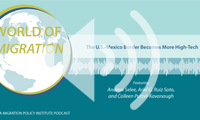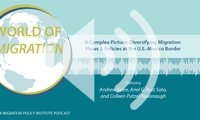
Colleen Putzel-Kavanaugh
Associate Policy Analyst
Colleen Putzel-Kavanaugh is an Associate Policy Analyst with MPI's U.S. Immigration Policy Program, where she focuses on the U.S.-Mexico border, including analysis of trends in border arrivals, migration at and between ports of entry, migrant processing, and the role of NGOs in border communities.
She comes to MPI after three years in San Diego, conducting research and working with asylum seekers at the U.S.-Mexico border.
Previously, Ms. Putzel-Kavanaugh interned with the Bipartisan Policy Center, the office of San Diego Mayor Todd Gloria, and Al Otro Lado. Prior to her work as a researcher, she was a 7th and 8th grade teacher.
Ms. Putzel-Kavanaugh holds a bachelor’s degree in English literature from Assumption College and a master’s of peace and justice degree from the University of San Diego’s Joan B. Kroc School of Peace Studies, where she focused on human rights, immigration, and corruption.
Bio Page Tabs
MPI President Andrew Selee and two colleagues who joined him at the U.S.-Mexico border to examine increasingly sophisticated U.S. Customs and Border Protection operations discuss the evolution of policies and procedures to address asylum seekers and other migrants arriving at official ports of entry.
How are U.S. border operations and policies evolving at the U.S.-Mexico border to address rising and diversifying flows? And what is driving increasing immigration from across Latin America, the Caribbean, and beyond? MPI President Andrew Selee speaks with two colleagues who traveled from one end of the nearly 2,000-mile boundary to the other, touring U.S. Customs and Border Protection facilities and interviewing U.S. and Mexican officials, NGO leaders, and others.









Shifting Patterns and Policies Reshape Migration to U.S.-Mexico Border in Major Ways in 2023
A Post-Title 42 Vision for Migration Management Comes into Focus